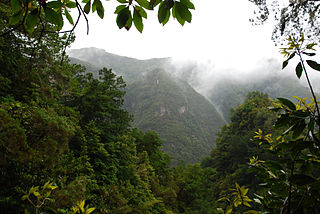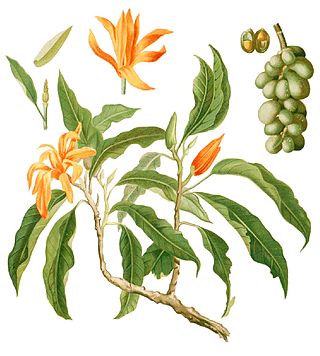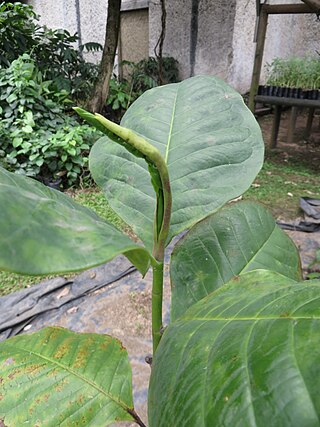
The Magnoliaceae are a flowering plant family, the magnolia family, in the order Magnoliales. It consists of two genera: Magnolia and Liriodendron.

Magnolia is a large genus of about 210 to 340 flowering plant species in the subfamily Magnolioideae of the family Magnoliaceae. The natural range of Magnolia species is disjunct, with a main center in east and southeast Asia and a secondary center in eastern North America, Central America, the West Indies, and some species in South America.

Laurel forest, also called laurisilva or laurissilva, is a type of subtropical forest found in areas with high humidity and relatively stable, mild temperatures. The forest is characterized by broadleaf tree species with evergreen, glossy and elongated leaves, known as "laurophyll" or "lauroid". Plants from the laurel family (Lauraceae) may or may not be present, depending on the location.

Magnolia wilsonii, or Wilson's magnolia, is a species of Magnolia native to China, in the provinces of western Guizhou, Sichuan and northern Yunnan, where it grows in the forest understory at altitudes of 1,900-3,000 m, rarely up to 3,300 m.

Magnolia hodgsonii, known in Chinese as gai lie mu is a species of Magnolia native to the forests of the Himalaya and southeastern Asia, occurring in Bhutan, southwestern China, Tibet, northeastern India, northern Myanmar, Nepal, and Thailand. It grows at moderate altitudes of 850–1500 m with a subtropical climate.

Magnolia champaca, known in English as champak, is a large evergreen tree in the family Magnoliaceae. It was previously classified as Michelia champaca. It is known for its fragrant flowers, and its timber used in woodworking.

Magnolia dealbata is a species of flowering plant in the family Magnoliaceae, native to Mexico. It is known commonly as the cloudforest magnolia and eloxochitl. It is sometimes considered to be a subspecies of Magnolia macrophylla, which is otherwise native to the southeastern United States.
Magnolia espinalii is a species of plant in the family Magnoliaceae. It is endemic to Colombia but critically endangered. According to López-A et al., as of 2008 there were only 23 known surviving trees in the wild. Common names include: hojarasco, magnolio de monte.
Magnolia guatapensis is a species of plant in the family Magnoliaceae. It is endemic to Colombia. Common names include: almanegra, almanegra de Guatapé.

Magnolia polyhypsophylla is a species of plant in the family Magnoliaceae. It is endemic to Colombia. It is known commonly as almanegra de ventanas.
Magnolia schiedeana is a species of flowering plant in the family Magnoliaceae. It is endemic to Mexico, where it occurs along the slopes of the Gulf of Mexico.

Magnolia yarumalense is a species of plant in the family Magnoliaceae. It is endemic to Colombia. Common names include: Gallinazo morado, gallinazo, boñigo (Barbosa), almanegra.

Phyllanthus anamalayanus is a species of plant in the family Phyllanthaceae. It is endemic to the Anamalai Hills in Coimbatore district in the state of Tamil Nadu, India. The species is a shrub or small tree occurring in the understorey of mid-elevation tropical wet evergreen forests in the Anamalai Hills, and is endemic to the Western Ghats. It is threatened by habitat loss.

Magnolia × alba, also known as the white champaca, white sandalwood, or white jade orchid tree, is a flowering plant of hybrid origin that is commonly cultivated in Southeast Asia and tropical regions of East Asia. Although the exact origin is uncertain, it is considered to be a hybrid of Magnolia champaca and Magnolia montana.

Magnolia portoricensis is a tree of the Caribbean region. Its vernacular names include jagüilla and Puerto Rico magnolia. It is native to Puerto Rico and it is found in the Toro Negro State Forest. It is an endangered tree and endemic to Puerto Rico. It is a dicot and a part of the family Magnoliaceae. It is an uncommon tree, found primarily in the central and western mountains at 500 to 925 m above sea level.

Magnolia liliifera, commonly known as egg magnolia, is a flowering tree native to the Indomalayan realm. It bears white to cream-colored flowers on terminal stems. The leaves are elliptical and get as large as 25 cm (10 in) long and 8 cm (3 in) wide. The tree ranges in height from 3.5 to 18.5 m in situ.

Magnolia vrieseana is a tree species of the family Magnoliaceae endemic to Indonesia, occurring in Sulawesi and Maluku.

Magnolia pterocarpa is a species of tree in the Magnoliaceae family that grows in South Asia.

Magnolia garrettii is a species of plant in the family Magnoliaceae. It is found in northern Thailand, northern Vietnam, and Yunnan, China.
Magnolia zamudioi is a species of flowering plant in the family Magnoliaceae. It is endemic to Mexico, where it is found in the mountains of southern Veracruz and Chiapas.
















